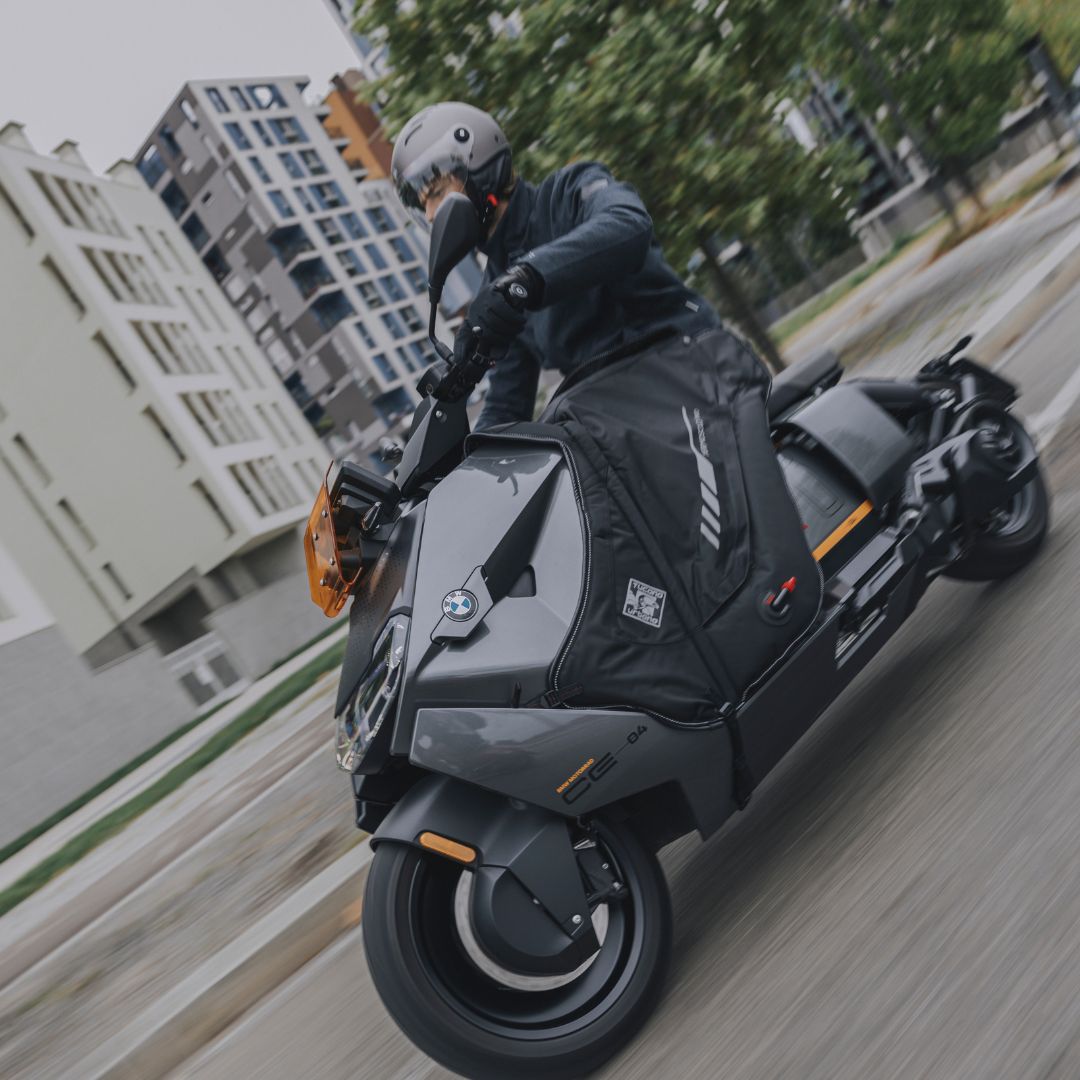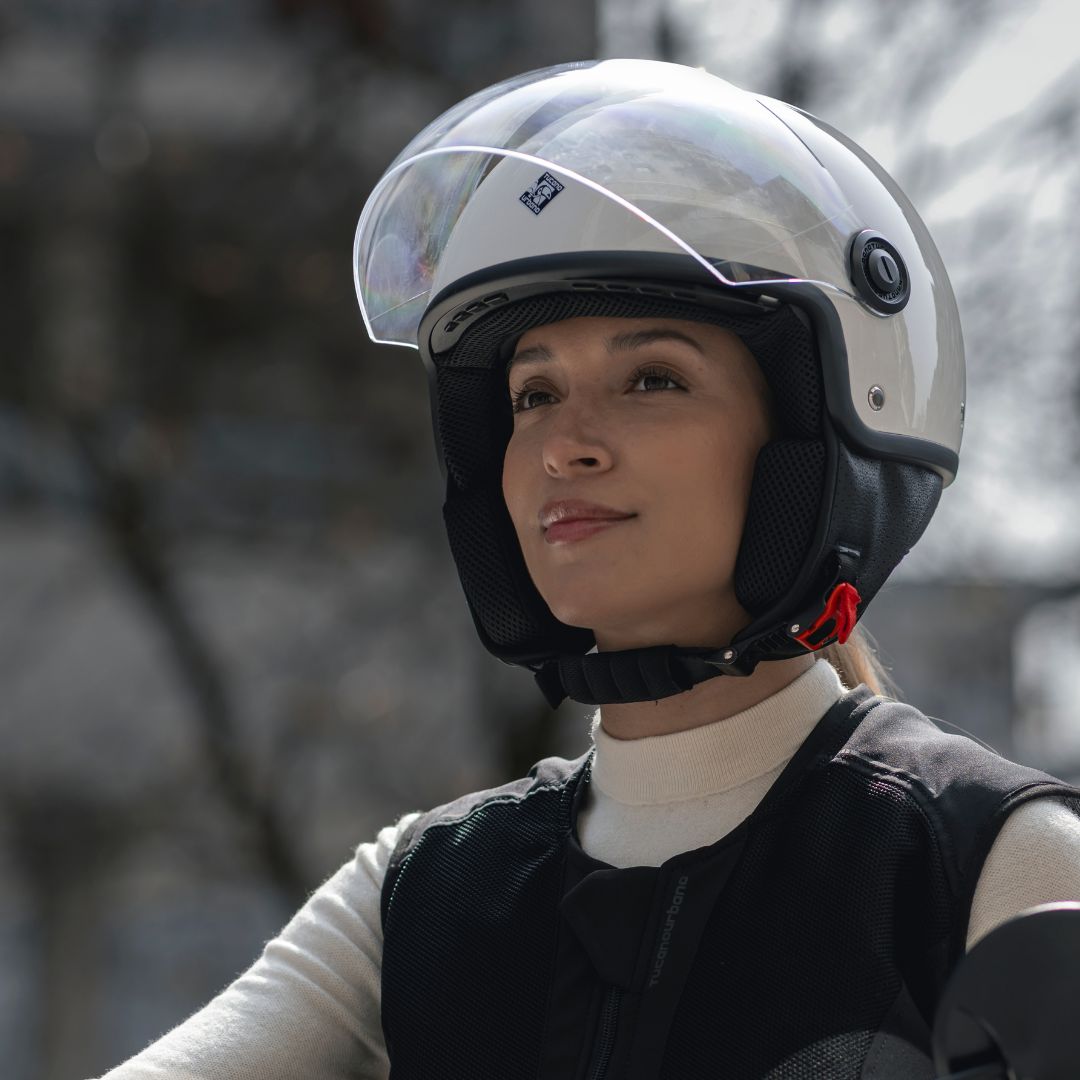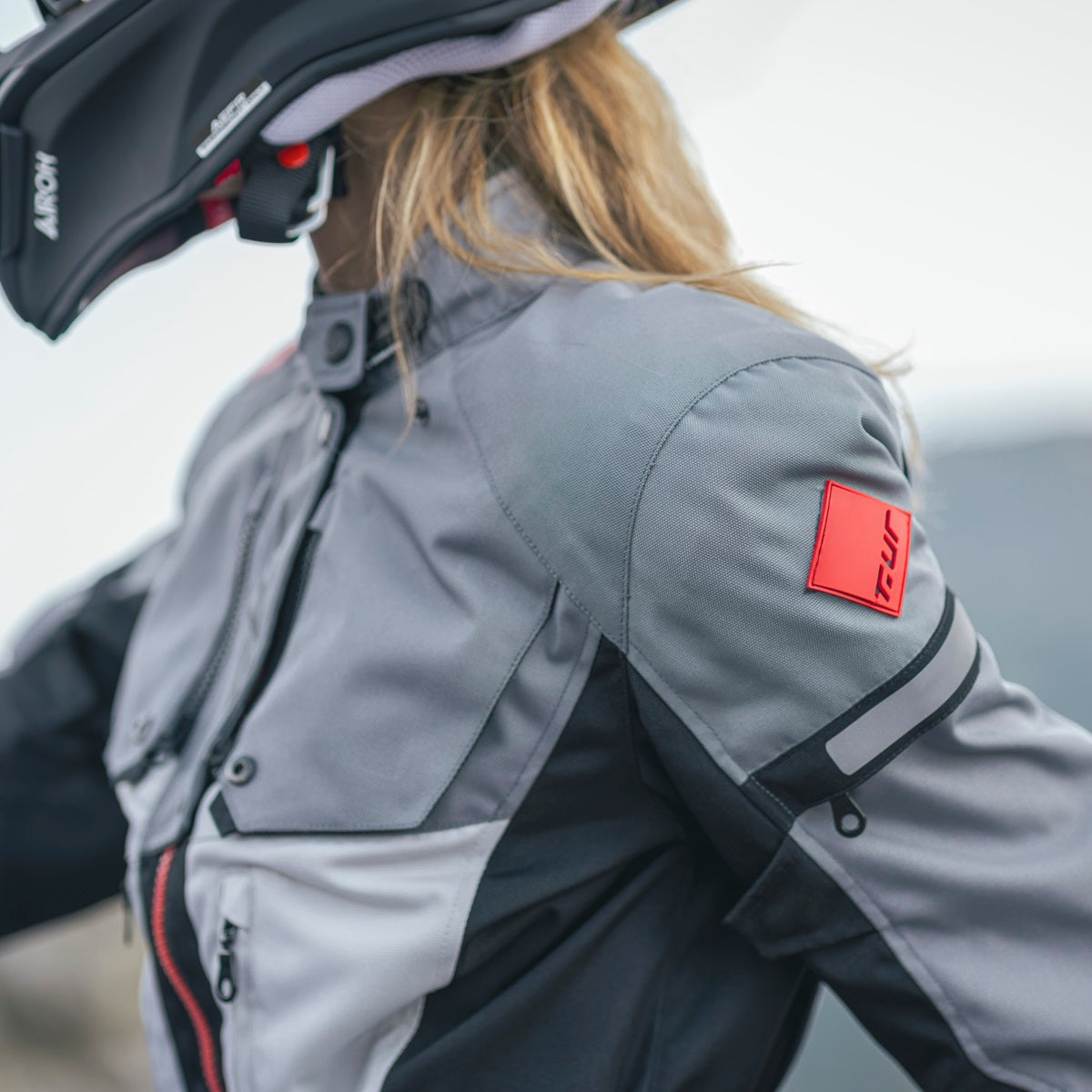CE-CERTIFIED
Gloves
Reference standards The glove is made in accordance with EU Regulation 2016/425 and complies with the requirements of standards EN 420 2003 A1:2009 and the standard document EN 13594:2015 "Gloves For Motorcycle Use."
Protection required
EN 13594:2015 now includes requirements for two different performance levels. Gloves with level 1 performance provide a primary level of protection but with greater dexterity than level 2, whereas level 2 gloves provide increased protection but there may potentially be weight and restriction penalties.
The tests covered by EN 13594 can be grouped into the following areas: Requirements that cover the general design of the glove, such as its overall length. Tests on the integrity of the whole glove, which include a measurement of the strength of seams or joints between pieces of material forming the protective layer. Tests on the innocuousness of the materials used to construct the glove. These include pH value and chrome VI content of any leather materials. The use of hard inclusions (such as metal studs or buckles) is also restricted to those which do not present a hazard to the user’s hand. To ensure that the rider can still ride safely while wearing the gloves, a procedure is included to assess the ergonomics of the glove. Tests to ensure the glove materials are sufficiently durable include an assessment of cut resistance using a reciprocating circular blade machine and a tear strength test. A test to assess the restraint of the glove on the wearer’s hand is also included, as clearly the glove will not offer any protection to the wearer if it is pulled or thrown off the hand during an accident. Finally, there is a test for impact protection which measures the product’s ability to reduce forces transmitted to the hand caused by an impact. This test is mandatory for all level 2 gloves, plus any gloves that are designed to attenuate impact energy.
TUCANO URBANO DECLARATION OF CONFORMITY
Click on the product name of your interest to download the document.
- ANDREW
- BARONE
- BARONESSA
- BOSS
- BREAK
- BRO
- BUD
- CONCEPT
- CRAB
- DEFENDER
- DIAMOND
- DUST
- EDEN
- EDENMESH
- ELISIA
- ELISIO
- GIG PRO
- GINKA 2G
- GINKA
- GINKO 2G
- GLOBIS
- GRANT
- HANDWARM
- HUB 2G
- HYDROWARM
- KEYWORD
- KRILL
- KRONOS
- LADY BOSS
- LADY BREAK
- LADY CONCEPT
- LADY DUST
- LADY EDEN
- LADY HUB 2G
- LADY MIKY
- LADY PASSWORD 3G
- LADY PASSWORD CE
- LADY PASSWORD PLUS
- LADY SPRINT
- LADY STACCA
- MARQUIS
- MIKY KID
- MIKY MESH
- MIKY
- MONTY TOUCH CE
- MRK 2
- MRK3
- NEW CRAB KRILL
- NEW MARY
- PASSWORD 3G
- PASSWORD PLUS
- PENNA MESH LADY
- PENNA MESH
- PENNA
- PIEGA
- SEPPIA 3G
- SEPPIAWARM
- SILVYA 2G
- SLALOM
- SOWARM
- SPRINT
- STACCA
- STARWARM HYDROSCUD
- STORMING
- SUPER MONTY
- SUPERMANO
- SUPERMARY
- TAAAC
- TARGET
- TURBO
- WARM CHANGER
- WENDY
- WILL
- WINDY
- WRK
- ZEUS 2G
T.UR DECLARATION OF CONFORMITY.
Click on the product name of your interest to download the document.
GARMENTS CE-CERTIFICATE
Reference standards
The jackets and trousers are made in accordance with EN 17092:2020 "Protective clothing for motorcycle riders". EN 17092:2020 works alongside EN 13595 and include all clothing marketed as "protective clothing for motorcyclists". It covers jackets and trousers as well as one- and two- piece suits, and includes a wide variety of tests intended to assess the protection and integrity of the clothing ensemble.
Protection required
EN 17092:2020 now includes requirements for four different performance levels Class AAA, AA, A, B and C garments. Class AAA garments. The highest level of protection, against the highest level of risks. Some common examples are: one-piece or two-piece suits. These garments are likely to have severe and limiting ergonomic, weight and thermal penalties, which some riders will not find acceptable for their specific riding activities. Class AA garments. The second highest level of protection, against the risks of the greatest diversity of riding activities. Some common examples are: garments designed to be worn by themselves or to be worn over other clothing. These garments are expected to have lower ergonomic and weight penalties than Class AAA garments and some riders will not find these penalties acceptable for their specific riding activities. Class A garments. The third highest level of protection. Some common examples are: garments, designed to be worn by themselves or to be worn over other clothing by riders in extremely hot environments. Class A garments are expected to have the least ergonomic and weight penalties. Class B garments. Certified only for abrasion resistance. Garments are designed to provide the equivalent abrasion protection of Class A garments but without the inclusion of impact protectors. One example is: jacket in elasticised mesh with certified back protector. Class C garments. Certified only for impact risk. Garments are designed to provide impact protection for areas covered by the impact protector(s) only, and they do not offer minimum abrasion protection. Class C garments are intended to be worn with and supplement the protection offered by Class AAA, AA, A or B garments. One example is: moto jackets without protectors.
The tests covered by EN 17092:2020 can be grouped into the following areas:
Impact abrasion resistance (Darmstadt method) This test simulates the stress that is placed on the protective garments when worn by an average rider with a body mass of 75kg and a height of 1.75m, when sliding from variable initial speeds to standstill on a real concrete road surface. In one run, three specimens of the material are mounted in holders attached to rotating arms positioned above a concrete tile (road surface). To pass, no holes with an opening of 5mm or more in any direction are to be present on the layer closest to the body. Strength of seams. Three test pieces of each seam, including all layers of materials from the garment that are present in the seam are tested according to the test procedure in EN 13594:2015. The seam strength is calculated by dividing the breaking force by the length of the tested seam. Tear strength. For textile garments, six ‘trouser leg’ type specimens are taken from each material of the garment and are torn apart using a standard tensile test machine. For leather garments, six ‘double edged tear’ specimens are taken from each material of the garment and torn apart, also using a standard tensile test machine. Materials shall be tested in two directions - warp and weft. Impact energy absorption. Elbow, shoulder, knee and hip impact protectors are to be present in Class AAA and AA garments as a mandatory requirement, with the hip protectors being optional in Class A garments. EN 1621 impact protectors must be positioned in the garment so that they cover the appropriate body part, according to the relevant impact protector standard. Dimensional stability. If the manufacturer’s instructions indicate that garments can be washed or dry cleaned, the test procedure for dimensional change for washing of protective clothing material is to be carried out in accordance with EN 13688. Measurement of dimensional change is carried out according to ISO 5077. Changes in dimension due to cleaning of material must not exceed ±3 percent for woven materials and ±5 percent for knitted material and nonwovens. Fit and ergonomics. Garments are to fit in accordance with the manufacturer’s size labelling and with the fit information supplied. The assessor must be able to carry out all the essential movements while wearing the test garment and all responses given by the assessor to the series of questions detailed in EN 17092:2020 must be positive. Garment restraint. Cones are used to exert a circumferential force to the sleeve restraint systems. The restraint systems must withstand this load without opening in order to pass the test.
TUCANO URBANO DECLARATION OF CONFORMITY
Click on the product name of your interest to download the document.
- 4 STROKE LADY
- 4 STROKE
- 4 TEMPI 2G LADY
- 4 TEMPI 2G
- AIRSCUD FLEX LADY
- AIRSCUD FLEX
- AIRSCUD JACKET
- AIRSCUD
- AMPEZZO
- AREAS_2G
- AREOS_2G
- ASFALT
- BAIA
- BELLA
- BOCCADASSE
- BORMIO KNIT
- BORMIO
- CORTINA
- DANTE
- DARIO
- DAVID
- DIRETTA
- DIRETTO
- DUOMO
- EASYSHELL WINDSCUD
- EASYSHELL WINDSCUD LADY
- ELETTRA
- FLOWMOTION LADY
- FLOWMOTION VEST LADY
- FLOWMOTION VEST
- FLOWMOTION
- FURBETTA
- GILET NETWORK CE
- GOLFO
- GULLIVER 2G
- HIFIVE
- HIGHMOTION LADY
- HIGHMOTION
- ICEMAN
- LEVANTE
- LIVIGNO
- MADDALENA
- MAGIC PARKA LADY
- MAGIC PARKA
- MANZONI
- MARK
- MASSIMO
- MISS
- MOLO
- MOLO SHORT
- MONTE
- NETWORK 2G
- NETWORK 3G
- NETWORK LADY 2G
- NETWORK LADY
- NEVADA
- NEW STEP
- ORBIS
- OVETTA CE
- OVETTO CE
- PANTAMOTO
- PANTAORBIS
- PEL 2G
- PELETTE 2G
- POL 2G
- POL-ICE
- PORTO
- QUARTO
- QUINTO
- REMO
- RIVS
- ROCKET
- SHELLMAX
- SIMON
- SPENCER
- STANLEY PARK
- STELLA
- SUPERLEGGERA
- SUPERLEGGERO
- TEXWORK 2G
- TEXWORK LADY
- TEXWORK
- TOP FIVE
- TWIN
- URBAN DISTRICT
- URBAN NETWORK
- URBANA 5G 2
- URBANA DISTRICT
- URBIS 5G
- VITTORIA
- VITTORIO
- WASHINGTON
- ZENA
- ZENO
- ZENO SHORT
- ZIPSTER 2G
T.UR DECLARATION OF CONFORMITY.
Click on the product name of your interest to download the document.
- AIRFLOW SHIELD LADY
- AIRFLOW SHIELD
- ATLAS LADY
- ATLAS
- ELBA LADY
- ELBA
- ETNA HYDROSCUD LADY
- ETNA HYDROSCUD
- FULLSTORM PANTS HYDROSCUD
- GIBRALTAR HYDROSCUD LADY
- GIBRALTAR HYDROSCUD
- HIMALAYA HYDROSCUD LADY
- HIMALAYA HYDROSCUD
- J-THREE ARM LINK
- LAPLAND HYDROSCUD
- LAPLAND LADY HYDROSCUD
- LAPLAND PANT HYDROSCUD
- LAPLAND PANT LADY
- NEVADA HYDROSCUD LADY
- NEVADA HYDROSCUD
- NIAGARA LADY
- NIAGARA
- PODIUM LADY
- PODIUM
- ROADBOOK HYDROSCUD
- SUPERCELL HYDROSCUD
- TASMANIA HYDROSCUD
- TASMANIA LADY HYDROSCUD
- TRANSFER LADY
- TRANSFER
- USHUAIA HYDROSCUD
- WAYPOINT HYDROSCUD LADY
- WAYPOINT HYDROSCUD
PROTECTOR
Reference standards The protectors is made in accordance with EU Regulation 2016/425 and complies with the requirements of standards EN 1621 Motorcyclists' protective clothing against mechanical impact. The standard is divided as follow:
EN 1621-1:2012 Motorcyclists' protective clothing against mechanical impact - Part 1: Motorcyclists' limb joint impact protectors - Requirements and test methods. UNI EN 1621-2:2014 Motorcyclists' protective clothing against mechanical impact - Motorcyclists' back protectors - Part 2: Requirements and test methods EN 1621-3:2018 Motorcyclists' protective clothing against mechanical impact — Part 3: Motorcyclists' chest protectors - Requirements and test methods EN 1621-4:2013 Motorcyclists' protective clothing against mechanical impact - Part 4: Motorcyclists' inflatable protectors - Requirements and test methods
Protection required
The standard EN 1621 specifies the minimum coverage to be provided by protectors worn by motorcyclists in normal traffic conditions. The standard contains the performance requirements for impact protectors and details of the test methods. This includes dimensional requirements, ergonomic requirements and safety, labelling and information presentation requirements.
TUCANO URBANO DECLARATION OF CONFORMITY
Click on the product name of your interest to download the document.
T.UR DECLARATION OF CONFORMITY.
Click on the product name of your interest to download the document.
ENHANCED VISIBILITY PRODUCTS EN 17353:2020
Reference standards The enhaced visibility products are made in accordance with EN 17353 'Enhanced visibility products'.
EN 17353 standard indicates conformity to Council Directive 89/686/EEC, implemented in Legislative Decree no. 475/92 as amended, so as to comply with EN 17353:2020 standard supersedes two separate standards: EN 1150:1999 – ‘Protective clothing. Visibility clothing for non-professional use. Enhanced visibility products are classified as PPE category II: this means that it protects the wearer against the relatively medium risk situations.
Protection required Enhanced Visibility Clothing is designed to make wearers more noticeable in moderate risk situations regardless of the daylight conditions or illumination by vehicle headlights or other light sources.
There are 3 designations to the EN 17353 standard:
Type A: Providing protection in daylight conditions and containing a minimal amount of fluorescent material.
Type B: Provides protection in the evenings and at night. This type is divided into 3 levels:
B1 – must have free handing reflectors – designed for movement recognition.
B2 – includes retroreflective devices or materials, either detachable or fixed on the limbs only.
B3 – includes retroreflective material on the torso or on the torso and limbs, designed for form recognition of the wearer.
Type AB: Provides protection in daylight, evening and at night. Type AB uses the fluorescent in addition to the retroreflective and/or combined enhanced visibility components.
The tests covered by EN 17353 can be grouped into the following areas:
Visibility: visibility from all sides shall be obtained by the following placement of fluorescent and/or reflective or combined-performance materials.
Not less than 40% of the minimum surface of the fluorescent and/or retroreflective material is present on both the front and the back when laid flat.
Not less than 10% of the minimum surface of the fluorescent and/or retroreflective material is present on both the right and left sides when laid flat.
Dimensional stability: if the manufacturer’s instructions indicate that garments can be washed or dry cleaned, the test procedure for dimensional change for washing of protective clothing material is to be carried out in accordance with EN 13688.
Measurement of dimensional change is carried out according to ISO 5077. Changes in dimension due to cleaning of material must not exceed ±3 percent for woven materials and ±5 percent for knitted material and nonwovens.
Fit and ergonomics: garments are to fit in accordance with the manufacturer’s size labelling and with the fit information supplied. The assessor must be able to carry out all the essential movements while wearing the test garment and all responses given by the assessor to the series of questions detailed in EN 17092:2020 must be positive.
Harmless materials: all materials are tested to guarantee the absence of hazardous materials.
T.UR DECLARATION OF CONFORMITY.
Click on the product name of your interest to download the document.
PROTECTION AGAINST RAIN UNI EN 343/2019
Reference standards The rainproof jackets, trousers and suites are made in accordance with EN 343:2019 'Protection against rain'.
EN 343:2019 standard indicates conformity to Council Directive 89/686/EEC, implemented in Legislative Decree no. 475/92 as amended, so as to comply with UNI EN340/2004 standard relating to the general requirements for protective clothing, and with product standard UNI EN 343/2019 for garments providing protection against rain that specifies the requirements and test methods applicable to the materials and seams of clothing providing protection against rain.
Rainproof clothing is classified as PPE category I: this means that it protects the wearer against the relatively small risk of adverse meteorological conditions.
Protection requiredRequirements and test methods for fabrics and seams of protective clothing against the influence of rain, snow, fog and ground humidity. Resistance to water penetration (A) and water vapour resistance (B) is measured.
Resistance to water penetration: 1-4, where class 4 provides the best waterproofness
Breathability – water vapour resistance: 1-4, where class 4 provides the best breathability Impact from above with high energy droplets (optional)
The EN 343 norm was updated during 2019 with the addition of class 4 (previously class 1-3). Fristads waterproof garments released during 2020 have been tested according to the new version of EN 343.
An ongoing update and recertification of existing garments is underway.
The tests covered by EN 343:2019 can be grouped into the following areas:
Water penetration: fabric are tested before and after pretreatment (cleaning, abrasion, flexiang, oil and fuel) Seams are tested before and after washing. Breathability is indicated in the RET value. The lower the RET value, the better the breathability.Dimensional stability: if the manufacturer’s instructions indicate that garments can be washed or dry cleaned, the test procedure for dimensional change for washing of protective clothing material is to be carried out in accordance with EN 13688. Measurement of dimensional change is carried out according to ISO 5077. Changes in dimension due to cleaning of material must not exceed ±3 percent for woven materials and ±5 percent for knitted material and nonwovens.
Fit and ergonomics: garments are to fit in accordance with the manufacturer’s size labelling and with the fit information supplied. The assessor must be able to carry out all the essential movements while wearing the test garment and all responses given by the assessor to the series of questions detailed in EN 17092:2020 must be positive.
Harmless materials: all materials are tested to guarantee the absence of hazardous materials
TUCANO URBANO DECLARATION OF CONFORMITY
Click on the product name of your interest to download the document.
T.UR DECLARATION OF CONFORMITY.
Click on the product name of your interest to download the document.
HEATED PRODUCTS
Reference standards
The heated accessories are manufactured in line with the following directives:
Regulation (EU) 2023/988 on general product safety
Directive 2014/35/EU known as the "Low Voltage Directive": This directive applies to electrical equipment designed for use with a voltage rating of between 50 and 1000 V for alternating current and between 75 and 1500 V for direct current (with the exception of certain materials declared in Annex II of the legislation);
Directive 2014/30/EU known as the 'Electromagnetic Compatibility Directive': regulates the electromagnetic compatibility of equipment. It aims to ensure the functioning of the internal market by requiring equipment to be con formed to an appropriate level of electromagnetic compatibility.
Directive (EU) 2015/863 known as "RoHS" replacing Directive 2011/65/EC: regulates the use of certain substances to ensure harmlessness.
Directive 2012/19/EU known as 'WEEE': provided for collection schemes where consumers returned their waste electrical and electronic equipment (WEEE) free of charge, with the aim of increasing its recycling and/or reuse.
Standard IEC 61882:2016 HAZOP: risk analysis method.
Standard IEC 61511-1:2016: provides criteria to ensure the reliability of SIS (Safety Instrumented Systems) based on the use of electrical, electronic or programmable electronic technology in the process industry. The IEC 61511 series also deals with a process hazard and risk assessment (H&RA) from which the specifications for SIS are derived. Part 1 - This is the only normative part of the series. It includes terminology and requirements for the specification, hardware design and application programming, commissioning, validation, operation, maintenance and testing of SIS components.
EN 55032:2015/AC:2016, EN 61000-3-2:2014, EN 61000-3-3:2013, EN 55024:2010/A1:2015
EN IEC 55014-1-2021, EN IEC 55014-2-2021, EN IEC 6100-3-2:2019, EN 61000-3-2013AMD.2:2021;
TUCANO URBANO DECLARATION OF CONFORMITY
Click on the product name of your interest to download the document.





